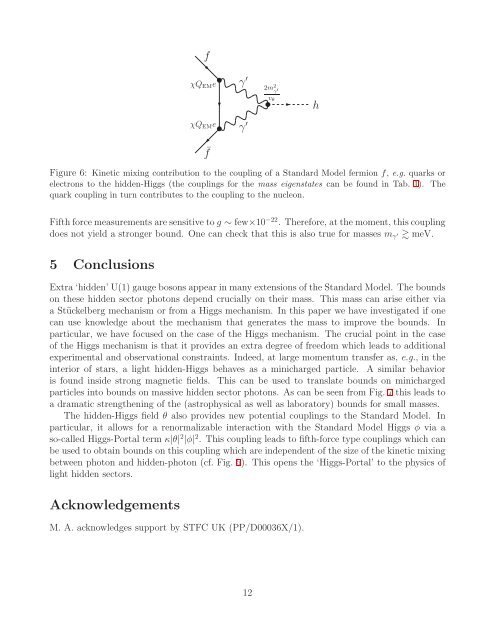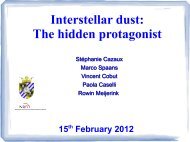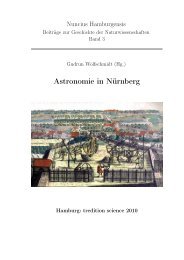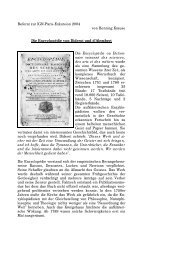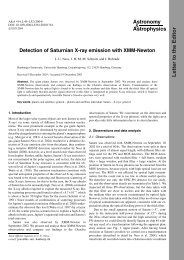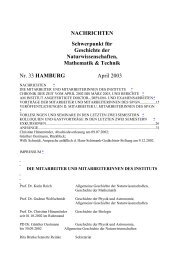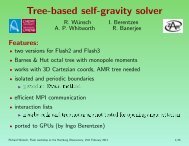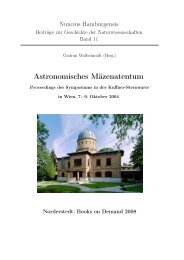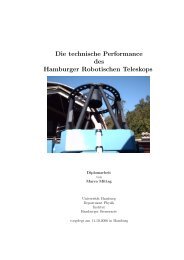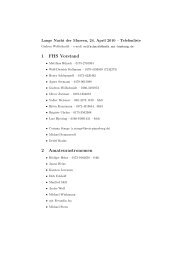Probing Hidden Sector Photons through the Higgs Window
Probing Hidden Sector Photons through the Higgs Window
Probing Hidden Sector Photons through the Higgs Window
You also want an ePaper? Increase the reach of your titles
YUMPU automatically turns print PDFs into web optimized ePapers that Google loves.
f<br />
χQ EM e<br />
χQ EM e<br />
¯f<br />
γ ′<br />
γ ′<br />
2m 2 γ ′<br />
v θ<br />
h<br />
Figure 6: Kinetic mixing contribution to <strong>the</strong> coupling of a Standard Model fermion f, e.g. quarks or<br />
electrons to <strong>the</strong> hidden-<strong>Higgs</strong> (<strong>the</strong> couplings for <strong>the</strong> mass eigenstates can be found in Tab. 1). The<br />
quark coupling in turn contributes to <strong>the</strong> coupling to <strong>the</strong> nucleon.<br />
Fifth force measurements are sensitive to g ∼ few×10 −22 . Therefore, at <strong>the</strong> moment, this coupling<br />
does not yield a stronger bound. One can check that this is also true for masses m γ ′ meV.<br />
5 Conclusions<br />
Extra ‘hidden’ U(1) gauge bosons appear in many extensions of <strong>the</strong> Standard Model. The bounds<br />
on <strong>the</strong>se hidden sector photons depend crucially on <strong>the</strong>ir mass. This mass can arise ei<strong>the</strong>r via<br />
a Stückelberg mechanism or from a <strong>Higgs</strong> mechanism. In this paper we have investigated if one<br />
can use knowledge about <strong>the</strong> mechanism that generates <strong>the</strong> mass to improve <strong>the</strong> bounds. In<br />
particular, we have focused on <strong>the</strong> case of <strong>the</strong> <strong>Higgs</strong> mechanism. The crucial point in <strong>the</strong> case<br />
of <strong>the</strong> <strong>Higgs</strong> mechanism is that it provides an extra degree of freedom which leads to additional<br />
experimental and observational constraints. Indeed, at large momentum transfer as, e.g., in <strong>the</strong><br />
interior of stars, a light hidden-<strong>Higgs</strong> behaves as a minicharged particle. A similar behavior<br />
is found inside strong magnetic fields. This can be used to translate bounds on minicharged<br />
particles into bounds on massive hidden sector photons. As can be seen from Fig. 7 this leads to<br />
a dramatic streng<strong>the</strong>ning of <strong>the</strong> (astrophysical as well as laboratory) bounds for small masses.<br />
The hidden-<strong>Higgs</strong> field θ also provides new potential couplings to <strong>the</strong> Standard Model. In<br />
particular, it allows for a renormalizable interaction with <strong>the</strong> Standard Model <strong>Higgs</strong> φ via a<br />
so-called <strong>Higgs</strong>-Portal term κ|θ| 2 |φ| 2 . This coupling leads to fifth-force type couplings which can<br />
be used to obtain bounds on this coupling which are independent of <strong>the</strong> size of <strong>the</strong> kinetic mixing<br />
between photon and hidden-photon (cf. Fig. 5). This opens <strong>the</strong> ‘<strong>Higgs</strong>-Portal’ to <strong>the</strong> physics of<br />
light hidden sectors.<br />
Acknowledgements<br />
M. A. acknowledges support by STFC UK (PP/D00036X/1).<br />
12


